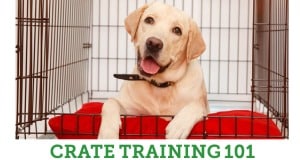
August is Clear the Shelters Month
August 8, 2020
Help Us Save Animals
October 6, 2020Putting a dog in a cage? It sounds cruel!
In reality though, crates can be wonderful and humane training and management tools. When using positive reinforcement methods, dogs end up loving their crates and often choose to spend quiet time resting in them.
Finding the Perfect Crate
- Style:
- Plastic crates, often called airline crates, are easy to clean and lighter weight, but don’t offer much ventilation and can be flimsy.
- Metal wire crates store flat, offer plenty of airflow and strength, but are heavier.
- We don’t recommend fabric crates unless your dog is already crate trained and you are simply looking for a stylish and lightweight crate to switch them over to using.
- Sizing
- For potty training purposes you want the crate to only be large enough for the dog to comfortably sit, lay, and turn around in. A good way to determine this is to measure your dog from the tip of the nose to the base of the tail and from the floor to the top of their head while they are sitting. Add 2-4 inches to these measurements to determine what a good potty-training-sized crate would be.
- Once potty training is complete feel free to upgrade your dog to a more spacious abode.
- Covers
- Some dogs like their crate covered with a blanket or sheet, and the visual barrier can promote rest and relaxation.
- Other dogs will find a blanket just another fun toy to pull through and chew up!
- Experiment while you’re still at home to see what works for your dog.
Crating as part of your Potty Training Plan
- Most dogs won’t potty in a small space such as a crate.
- Don’t leave your puppy or dog in a crate for longer than they can reliably control their bladder. This will cause your dog to be forced to potty in their crate which will hinder your potty training efforts greatly.
- If your dog is often pottying in the crate, set up a camera so you can see when she is pottying which will help you assess why. You may need to simply shorten the length of time she’s crated, or you may be dealing with separation anxiety.
Crating as a Management Tool
- For when you’re away:
- To prevent escape. Most dogs who are left outside while their owners are away from the home eventually escape the yard. A crate is often a safer alternative.
- To prevent destruction in your home. Dogs who have not been taught to only chew on appropriate things will often destroy household items when left alone.
- For when you’re at home but it’s unsafe for them to be free:
- to prevent them from running out the front door while you have it open to bring in groceries or greet guests.
- In multi dog households or for dogs with resource guarding behavior: Crated dogs can’t bully or be bullied while enjoying meals or high value chews.
Getting Started the Right Way
For whatever reason you are choosing to crate train, it’s important to make being in the crate a positive experience for the dog. The easiest way to do this is by using food!
-
- My crate is a magical snack machine! Start by simply placing a few treats in the crate throughout the day. The dog will walk by and notice the pleasant surprise.
- Crate training is fun! Repeat each of these steps a few times before moving on to the next:
-
-
- Lure your dog into the crate by tossing a treat towards the back, let dog exit at will.
- Lure your dog into the crate, continue feeding treats every 1-2 seconds as long as dog stays in the crate, let dog exit
- Hand signal your dog into the crate, close door, feed a treat, open door, let dog exit.
- Hand signal your dog into the crate, close door, stay nearby and feed a treat every 5-10 seconds for one minute, let dog exit.
- Hand signal your dog into the crate, close door, walk around the room and feed a treat every 15-20 seconds for a few minutes, let dog exit.
- Hand signal your dog into the crate, give your dog a high value chew or stuffed kong, close door, walk around your home, coming back to the dog to feed a treat every few minutes until they have finished the chew item, let them exit.
- From here you can slowly increase the length of time the dog stays in the crate, and decrease both the frequency of treats given and how often you appear back into the room.
- After they are very comfortable in the crate while you’re home, you can start leaving them for short periods. Work up to longer and longer periods in the crate.
-
While this may seem like many steps, most dogs can blow through this crate training plan in a single weekend! It’s important to work at your particular dog’s pace though. If your dog is showing discomfort or anxiety during any steps, do more repetitions of the previous step.
-
- My family loves it when I chose this place to rest! Keep a jar of treats close to the crate. Anytime you catch your dog laying in or even just checking out the crate, reward her with a treat!
- Tasty things happen in the crate! Feed meals and high value chews inside of the crate.
Confinement Anxiety and Separation Anxiety
- Some dogs find being alone a very scary time. For these dogs being in a small space can often intensify these feeling. If you worry your dog has separation or confinement anxiety, contact a professional, positive reinforcement, dog trainer for support.
While crate training can be a handy skill for dogs to have, spending too much time in a crate away from loved ones can be detrimental to a dog’s mental and physical health. Just like humans, our dogs need ample time to play, socialize with us, do enrichment activities and get exercise and opportunities to explore.
Angela Rodriguez owns The Joyful Hound, a dog walking and training business in midtown Tulsa. When she is not taking care of people’s pets she is working at the Tulsa SPCA as their Training and Assessment Specialist. There she uses her education and skills to set shelter dogs up for success in loving homes.


